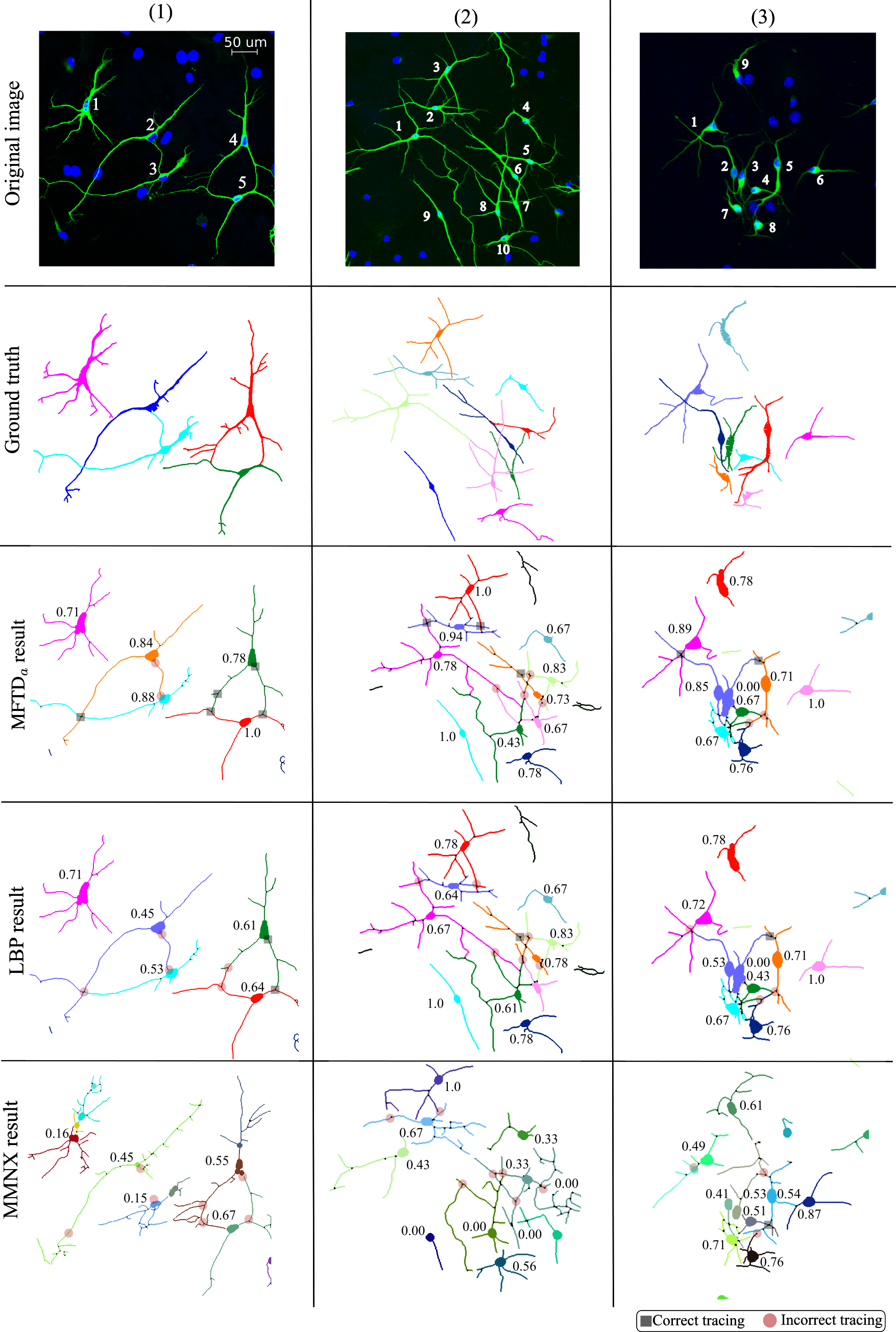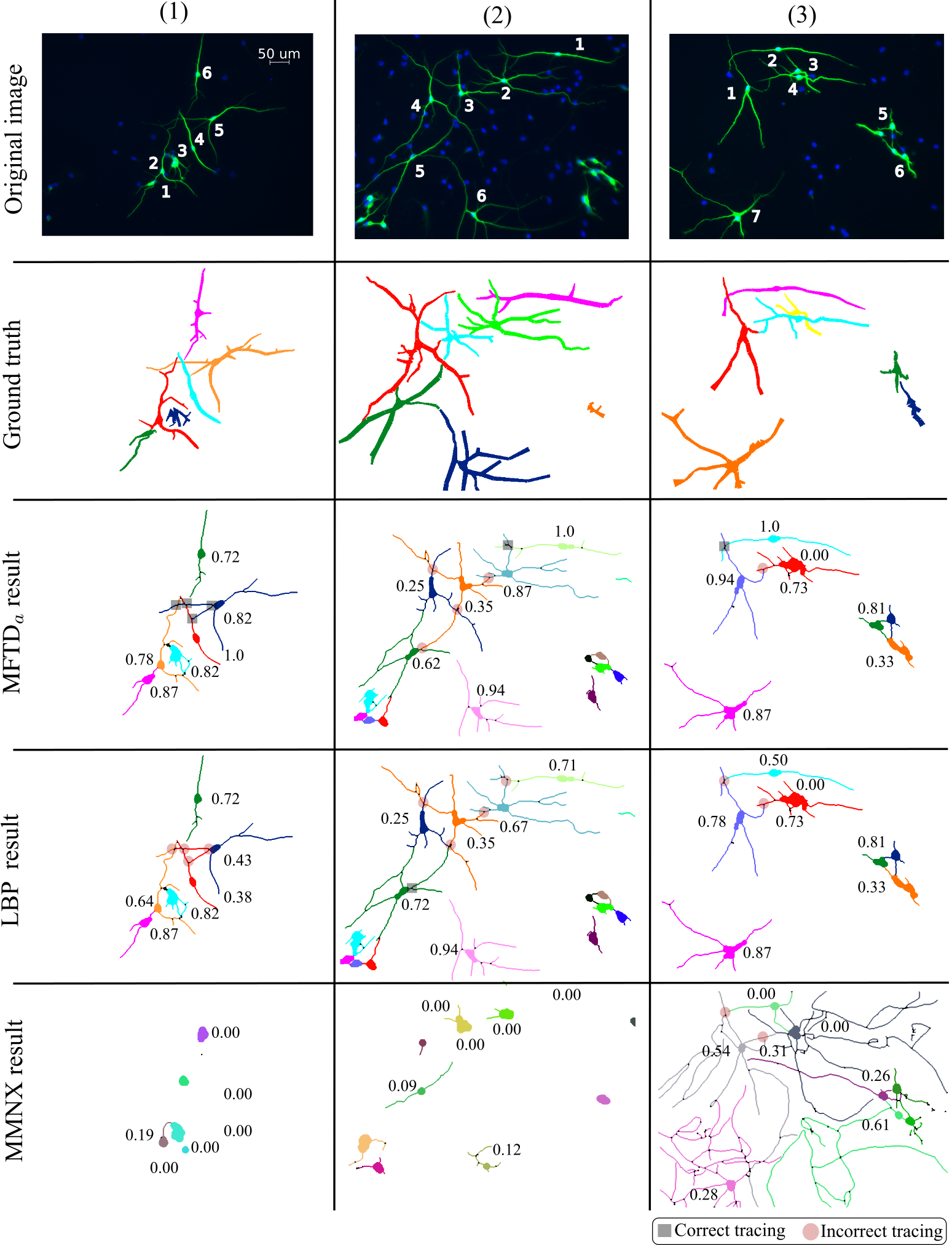Tracing using matrix forest theotem on a digraph (MFTD)
Our work aims at tracing filamentary structures in both neuronal and retinal images.
It is often crucial to identify single neurons in neuronal networks, or separate vessel tree structures in retinal blood vessel networks, in applications such as drug screening for neurological disorders or computer-aided diagnosis of diabetic retinopathy.
Both tasks are challenging as the same bottleneck issue of filament crossovers is commonly encountered, which essentially hinders the ability of existing systems to conduct large-scale drug screening or practical clinical usage.
To address this problem, a two-step graph-theoretical approach is proposed in this paper.
To address this problem, a two-step graph-theoretical approach is proposed in this paper.
First step focuses on segmenting filamentary pixels out of the background.
This produces a filament segmentation map used as input for the second step, where they are further separated into disjoint filaments.
Key to our approach is the idea that the problem can be reformulated as label propagation over directed graphs,
such that the graph is to be partitioned into disjoint sub-graphs,
or equivalently, each of the neurons (vessel trees) is separated from the rest of the neuronal (vessel) network.
This enables us to make the interesting connection between the tracing problem and the digraph matrix-forest theorem in algebraic graph theory for the first time.
|
Empirical experiments are done on following datasets.
Neuronal image dataset:
In collaboration with Institute of Medical Biology and Institute of Molecular and Cell Biology, we have collected and annotated 210 neuronal images. Neurons are grown in-vitro from embrionic stem cells
and they are stained with two markers, one for neurite channel (GFP) and another one for nuclei channel (DAPI). Two channel images are captured using light microscopes with 20x resolution. Dataset and ground-truth
annotations can be downloaded from here. Few exemplary images and their ground-truths are shown below.
-
Neuron dataset batch 1 (neuB1) :
-
Neuron dataset batch 2 (neuB2) :
DRIVE:
This dataset is from Image Science Institute, Netherlands. To know more and download the dataset kindly visit this webpage. The ground truth ".swc" files for tracing can be downloaded from here.STARE:
This dataset is from National Institutes of Health, United States. To know more and download the dataset kindly visit this webpage. The ground truth ".swc" files for tracing can be downloaded from here.
- DIADEM Score:
We have adopted DIADEM Metric from the Diadem Challange to evaluate the performance of our algorithm. The MATLAB code to convert a traced image file to DIADEM metric compatible ".swc" file is provided here. To know more about this conversion kindly refer to [2]. Kindly go through the README file before using the script.
- Our methods : MFTDa, MFTDb, MFTDc, MFTDd.
- Other methods (used on our segmentation results) : SGL, ZFL, LLGC, MF, TRW, LBP.
- Tools and softwares : MMNX (Metamerph NX from Molecular Devices) and NC (Neurocyto).
See the reference tab for more details.
Table for DIADEM score comparision
| | MFTDa | MFTDb | MFTDc | MFTDd | SGL | ZFL | LLGC | MF | TRW | LBP | MMNX | NC |
| NeuB1 | 0.52 | 0.51 | 0.51 | 0.41 | 0.45 | 0.47 | 0.50 | 0.38 | 0.46 | 0.42 | 0.43 | 0.36 |
| NeuB2 | 0.18 | 0.16 | 0.17 | 0.13 | 0.14 | 0.15 | 0.14 | 0.12 | 0.14 | 0.13 | 0.13 | 0.12 |
| DRIVE | 0.82 | 0.79 | 0.80 | 0.69 | 0.73 | 0.76 | 0.79 | 0.63 | 0.73 | 0.68 | - | - |
| STARE | 0.43 | 0.42 | 0.43 | 0.28 | 0.36 | 0.39 | 0.41 | 0.31 | 0.37 | 0.34 | - | - |
Visual examples
NeuB1
NeuB2
Retina
- Tracing Retinal Blood Vessels by Matrix-Forest
Theorem of Directed Graphs. In MICCAI, September, 2014.
- Jaydeep De, Huiqi Li, Li Cheng. Tracing retinal vessel trees by transductive inference. In BMC Bioinformatics, 15(20):1–20, 2014. [pdf]
- Jaydeep De, Tengfei Ma, Huiqi Li, Manoranjan Dash, Li Cheng. Automated Tracing of Retinal Blood Vessels Using Graphical Models. In 18th Scandinavian Conference on Image Analysis, Espoo, Finland, June, 2013. [pdf]
References
- SGL : Symetrized graph laplacian. D. Zhou, J. Huang, and B. Scholkopf, “Learning from labeled and unlabeled data on a directed graph,” in ICML, 2005.
- ZFL : Zero-mode free laplacian. H. Wang, C. Ding, and H. Huang, “Directed graph learning via high-order co-linkage analysis,” in ECML, 2010.
- LLGC : Learning with local and global consistency method. D. Zhou, O. Bousquet, T. Lal, J. Weston, and B. Scholkopf, “Learning with local and global consistency,” in NIPS, 2004.
- MF, TRW, LBP : Mean field, Tree reweighted, Loopy belief propagation inference method of graphical model. M. Wainwright and M. Jordan, Graphical models, exponential families, and variational inference, ser. Foundations and trends in machine learning. Hanover: Now Publisher, 2008.
- Neurocyto : W. Yu, H. Lee, s. Hariharan, W. Bu, and S. Ahmed, “Quantitative neurite outgrowth measurement based on image segmentation with topological dependence,” Cytometry Part A, vol. 75A, no. 4, pp. 289–297, 2009.






